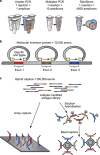New challenges for BRCA testing: a view from the diagnostic laboratory
- PMID: 27514839
- PMCID: PMC5141576
- DOI: 10.1038/ejhg.2016.94
New challenges for BRCA testing: a view from the diagnostic laboratory
Abstract
Increased demand for BRCA testing is placing pressures on diagnostic laboratories to raise their mutation screening capacity and handle the challenges associated with classifying BRCA sequence variants for clinical significance, for example interpretation of pathogenic mutations or variants of unknown significance, accurate determination of large genomic rearrangements and detection of somatic mutations in DNA extracted from formalin-fixed, paraffin-embedded tumour samples. Many diagnostic laboratories are adopting next-generation sequencing (NGS) technology to increase their screening capacity and reduce processing time and unit costs. However, migration to NGS introduces complexities arising from choice of components of the BRCA testing workflow, such as NGS platform, enrichment method and bioinformatics analysis process. An efficient, cost-effective accurate mutation detection strategy and a standardised, systematic approach to the reporting of BRCA test results is imperative for diagnostic laboratories. This review covers the challenges of BRCA testing from the perspective of a diagnostics laboratory.
Conflict of interest statement
AW has received payments for speaker services from AstraZeneca and payments for consultancy from AstraZeneca and Roche Products.
Figures




Similar articles
-
BRCA somatic and germline mutation detection in paraffin embedded ovarian cancers by next-generation sequencing.Oncotarget. 2016 Jan 12;7(2):1076-83. doi: 10.18632/oncotarget.6834. Oncotarget. 2016. PMID: 26745875 Free PMC article.
-
Simultaneous detection of BRCA mutations and large genomic rearrangements in germline DNA and FFPE tumor samples.Oncotarget. 2016 Sep 20;7(38):61845-61859. doi: 10.18632/oncotarget.11259. Oncotarget. 2016. PMID: 27533253 Free PMC article.
-
BRCA1/2 somatic mutation detection in formalin-fixed paraffin embedded tissue by next-generation sequencing in Korean ovarian cancer patients.Pathol Res Pract. 2019 Nov;215(11):152595. doi: 10.1016/j.prp.2019.152595. Epub 2019 Aug 16. Pathol Res Pract. 2019. PMID: 31570282
-
BRCA1 and BRCA2 genetic testing-pitfalls and recommendations for managing variants of uncertain clinical significance.Ann Oncol. 2015 Oct;26(10):2057-65. doi: 10.1093/annonc/mdv278. Epub 2015 Jul 7. Ann Oncol. 2015. PMID: 26153499 Free PMC article. Review.
-
Finding all BRCA pathogenic mutation carriers: best practice models.Eur J Hum Genet. 2016 Sep;24 Suppl 1(Suppl 1):S19-26. doi: 10.1038/ejhg.2016.95. Eur J Hum Genet. 2016. PMID: 27514840 Free PMC article. Review.
Cited by
-
Genetic Counseling, Testing, and Management of HBOC in India: An Expert Consensus Document from Indian Society of Medical and Pediatric Oncology.JCO Glob Oncol. 2020 Jul;6:991-1008. doi: 10.1200/JGO.19.00381. JCO Glob Oncol. 2020. PMID: 32628584 Free PMC article.
-
Clinical Evaluation of BRCA1/2 Mutation in Mexican Ovarian Cancer Patients.Transl Oncol. 2020 Feb;13(2):212-220. doi: 10.1016/j.tranon.2019.11.003. Epub 2019 Dec 20. Transl Oncol. 2020. PMID: 31869745 Free PMC article.
-
Identification of novel BRCA1 large genomic rearrangements by a computational algorithm of amplicon-based Next-Generation Sequencing data.PeerJ. 2019 Nov 15;7:e7972. doi: 10.7717/peerj.7972. eCollection 2019. PeerJ. 2019. PMID: 31741787 Free PMC article.
-
Identification of the most common BRCA alterations through analysis of germline mutation databases: Is droplet digital PCR an additional strategy for the assessment of such alterations in breast and ovarian cancer families?Int J Oncol. 2022 May;60(5):58. doi: 10.3892/ijo.2022.5349. Epub 2022 Apr 6. Int J Oncol. 2022. PMID: 35383859 Free PMC article.
-
Implementation of Multigene Germline and Parallel Somatic Genetic Testing in Epithelial Ovarian Cancer: SIGNPOST Study.Cancers (Basel). 2021 Aug 27;13(17):4344. doi: 10.3390/cancers13174344. Cancers (Basel). 2021. PMID: 34503154 Free PMC article.
References
-
- Mavaddat N, Peock S, Frost D et al: Cancer risks for BRCA1 and BRCA2 mutation carriers: results from prospective analysis of EMBRACE. J Natl Cancer Inst 2013; 105: 812–822. - PubMed
-
- Kluger J, Park A: The Angelina Effect. TIME Magazine 2013; 181: 28–33. - PubMed
-
- NCCN Clinical Practice Guidelines: Genetic/familial high-risk assessment: breast and ovarian, version 1.2014. J Natl Compr Canc Netw 2014; 12: 1326–1338. - PubMed
Publication types
MeSH terms
Substances
LinkOut - more resources
Full Text Sources
Other Literature Sources
Medical
Miscellaneous

